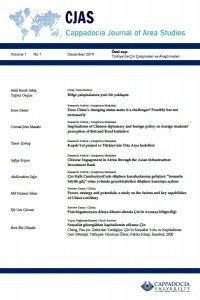Bölge Çalışmaları modeline eleştirel bir bakış: Bölge Çalışmaları alanındaki güncel eğilimler üzerine kısa bir çalışma
Sömürgecilik yıllarında ortaya çıkışından itibaren Bölge Çalışmaları politika odaklı bir gelişim çizgisi izlemiştir. Eski sömürge topraklarının etüt edilmesinden Soğuk Savaş’ın stratejik bölgelerine, 11 Eylül 2001 saldırılarından günümüze kadar, Bölge Çalışmaları disiplini hükûmetlerle birlikte politika hedeflerine ulaşma yönünde çaba sarf etmiştir. Middle East Studies after September 11: Neo-Orientalism, American Hegemony and Academia kitabını temel alan bu çalışmada Bölge Çalışmaları’nın tarihsel gelişim çerçevesi ve alandaki güncel eğilimler eleştirel bir bakış açısıyla incelenmektedir. Alandaki dikkate değer eğilimler arasında, son on yılda ABD merkezli akademik çalışmaların odağını Doğu Asya’ya kaydırması ve ABD ve Avrupa merkezli olmayan Bölge Çalışmaları modelinin tercih edilmeye başlanmasıdır. İkinci eğilimle ilgili olarak bu kısa çalışma Çin tarafından bazı olumsuz özellikleri ile birlikte benimsenen Bölge Çalışmaları modelini incelemektedir. Çalışma Bölge Çalışmaları diyalektiğine eleştirel yaklaşarak geleneksel çevreler dışındaki aktörler tarafından benimsenmesi durumunda da sömürgeci, emperyalist ve Oryantalist özelliklerin Bölge Çalışmaları alanına intikal edip etmediğini sorgulamaktadır.
Anahtar Kelimeler:
Bölge Çalışmaları, eleştirel yaklaşım, ABD-merkezli yaklaşım, Çin, tarihsel analiz
A critical overview of the Area Studies model: A brief study of the current trends in Area Studies
Since its inception in the colonial era, Area Studies (AS) has evolved in accordance with policy-oriented demands. From the study of former colonial territories to strategic areas of the Cold War, and from September 11, 2001 through to the present day, this academic field has been entangled with government, with an impetus aimed at achieving policy goals. Using the seminal book Middle East Studies after September 11: Neo-Orientalism, American Hegemony and Academia as its basis, we present here a critical examination of historical context of the evolution of Area Studies and the current trends in the field. Some of the notable current trends in the field include observable rotations in area focus that over the last decade have manifested in a geospatial shift of focus to East Asia by US-centric academia, and the adoption of AS as a model outside of the United States and Europe. Regarding the latter, this brief study investigates the adaptation of an AS model by China, noting the transference of the practical negative attributes of AS, and critically engages in the AS dialectic by asking the question of whether the colonial, imperialist and Orientalist history and attributes of AS are inherent to the field when adopted by actors from outside its traditional milieu.
Keywords:
Area Studies, critical approach, US-centric approach, China, historical analysis,
___
- CMEPS. n.d. “Center for Middle East Peace Studies” Shanghai Jiao Tong University. http://iah.sjtu.edu.cn/en/ME/index.asp?TypeID=50&ID=206.
- CNAS. 2020. “CNAS Supporters” Center for a New American Security. Accessed June 8, 2020. https://www.cnas.org/support-cnas/cnas-supporters.
- Connable, Ben. 2012. Military Intelligence Fusion for Complex Operations: A New Paradigm. Rand Corporation Occasional Paper Series. Santa Monica, Calif.: Rand National Defense Research Institute.
- Hanifi, Shah Mahmoud. 2018. “A Genealogy of Orientalism in Afghanistan: The Colonial Image Lineage.” In Middle East Studies after September 11: Neo-Orientalism, American Hegemony and Academia, edited by Tugrul Keskin, 50–80. Studies in Critical Social Sciences, volume 120. Leiden ; Boston: Brill.
- Hundley, Lindsay, Benjamin Kenzer, and Susan Peterson. 2015. “What Pivot? International Relations Scholarship and the Study of East Asia.” International Studies Perspectives 16 (3): 286–301. https://doi.org/10.1111/insp.12060.
- IGS. n.d. “Institute for Global Studies Research Centers” Shanghai University. http://igse.shu.edu.cn/Research_Centers.htm. “International and Foreign Language Education Annual Report 2017.” 2019. Washington D.C.: US Department of Education, Office of Postsecondary Education. https://www2.ed.gov/about/offices/list/ope/iegps/2017ifleannualreport.pdf.
- Jiang, Shixue. 2020. “Area Studies in China: Progress and Problems.” Shanghai Institutes for International Studies (SIIS). January 1, 2020. http://www.siis.org.cn/Research/EnInfo/1671.
- Keskin, Tugrul, ed. 2018. Middle East Studies after September 11: Neo-Orientalism, American Hegemony and Academia. Studies in Critical Social Sciences, volume 120. Leiden ; Boston: Brill.
- Ma, Yaoli. 2018. “The Opening Ceremony of Institute of Area Studies Held.” Peking University News. April 17, 2018. http://newsen.pku.edu.cn/news_events/news/focus/7016.htm.
- Myers, Margaret, Ricardo Barrios, and Guo Cunhai. 2018. “China’s Strategy for Area Studies Development.” The Dialogue, no. Latin America and the World (June): 12. https://www.thedialogue.org/analysis/learning-latin-america-chinas-strategy-for-area-studies-development/.
- Patton, Kerry. 2010. Sociocultural Intelligence: A New Discipline in Intelligence Studies. Continuum Intelligence Studies Series. New York: Continuum.
- Powell, Richard C., Ian Klinke, Tariq Jazeel, Patricia Daley, Ng’wanza Kamata, Michael Heffernan, Adam Swain, Fiona McConnell, Andrew Barry, and Richard
- Phillips. 2017. “Interventions in the Political Geographies of ‘Area.’” Political Geography 57 (March): 94–104. https://doi.org/10.1016/j.polgeo.2016.03.004.
- SIIS. n.d. “Institutes” Shanghai Institutes for International Studies. http://www.siis.org.cn/Content/List/4TY1S03HDEZN.
- Başlangıç: 2019
- Yayıncı: Kapadokya Üniversitesi
